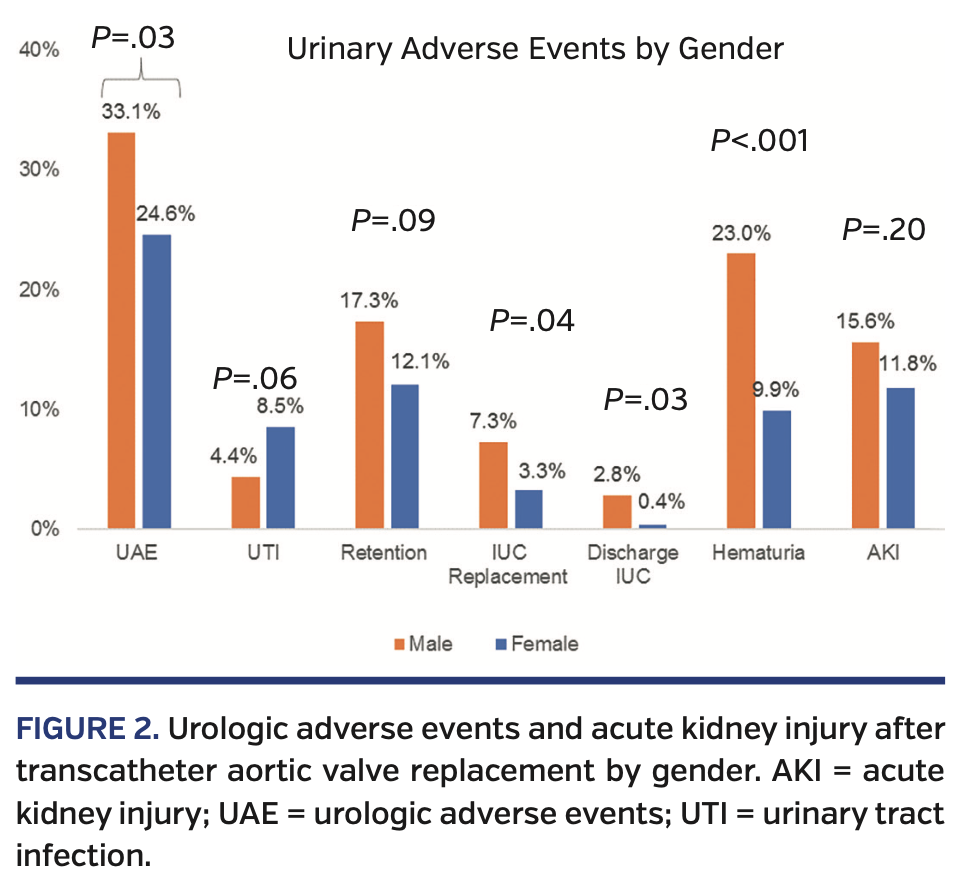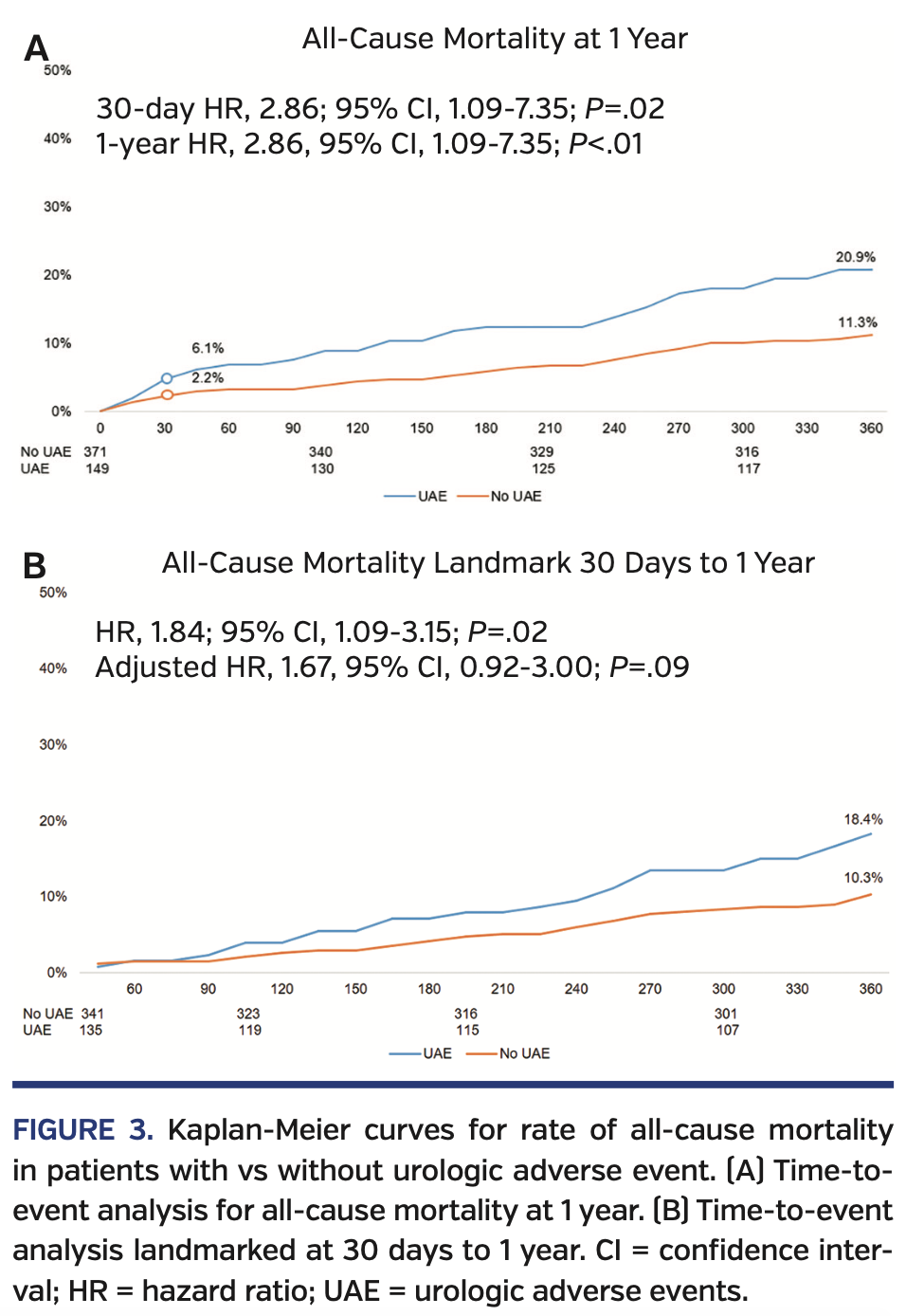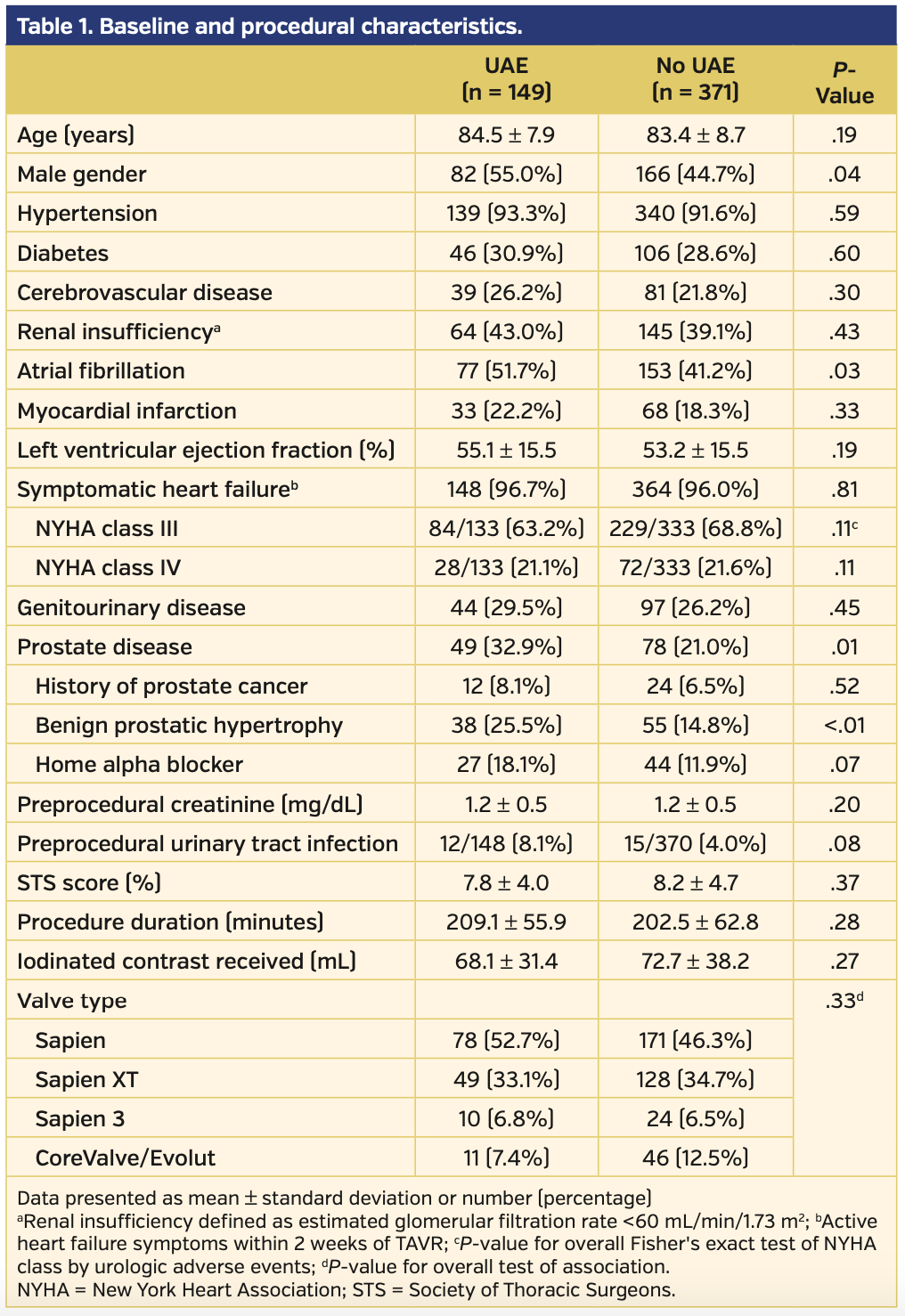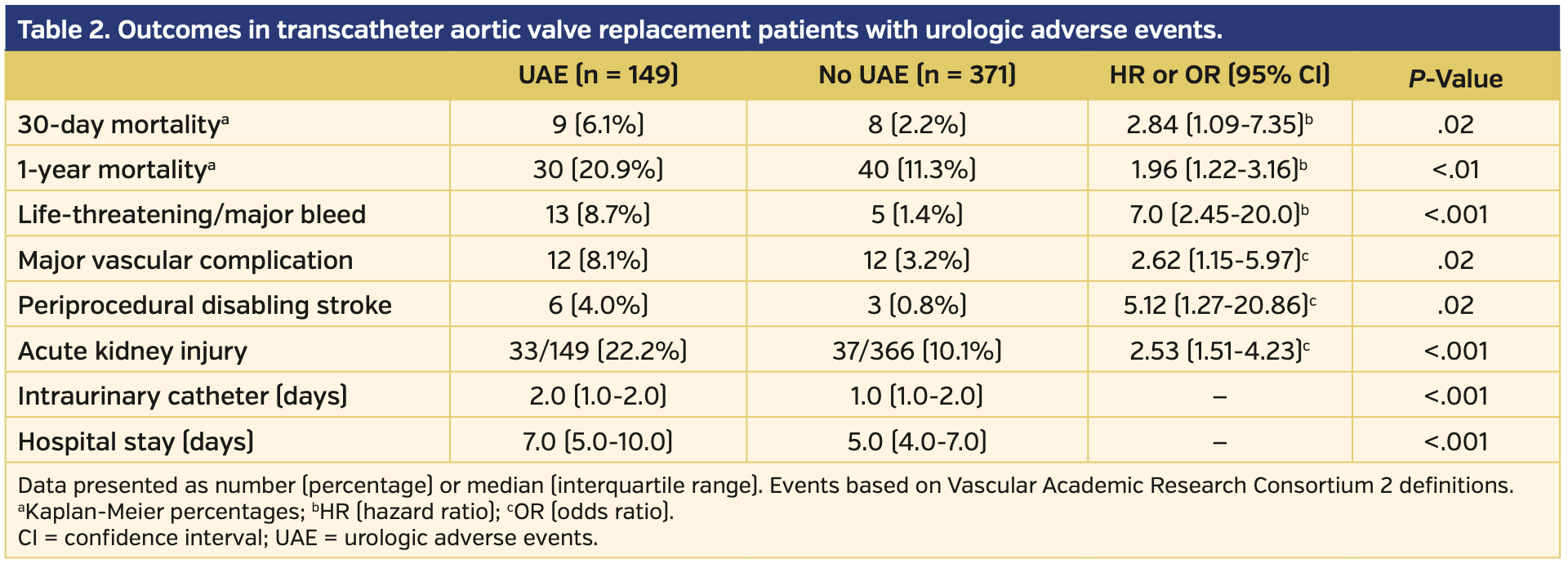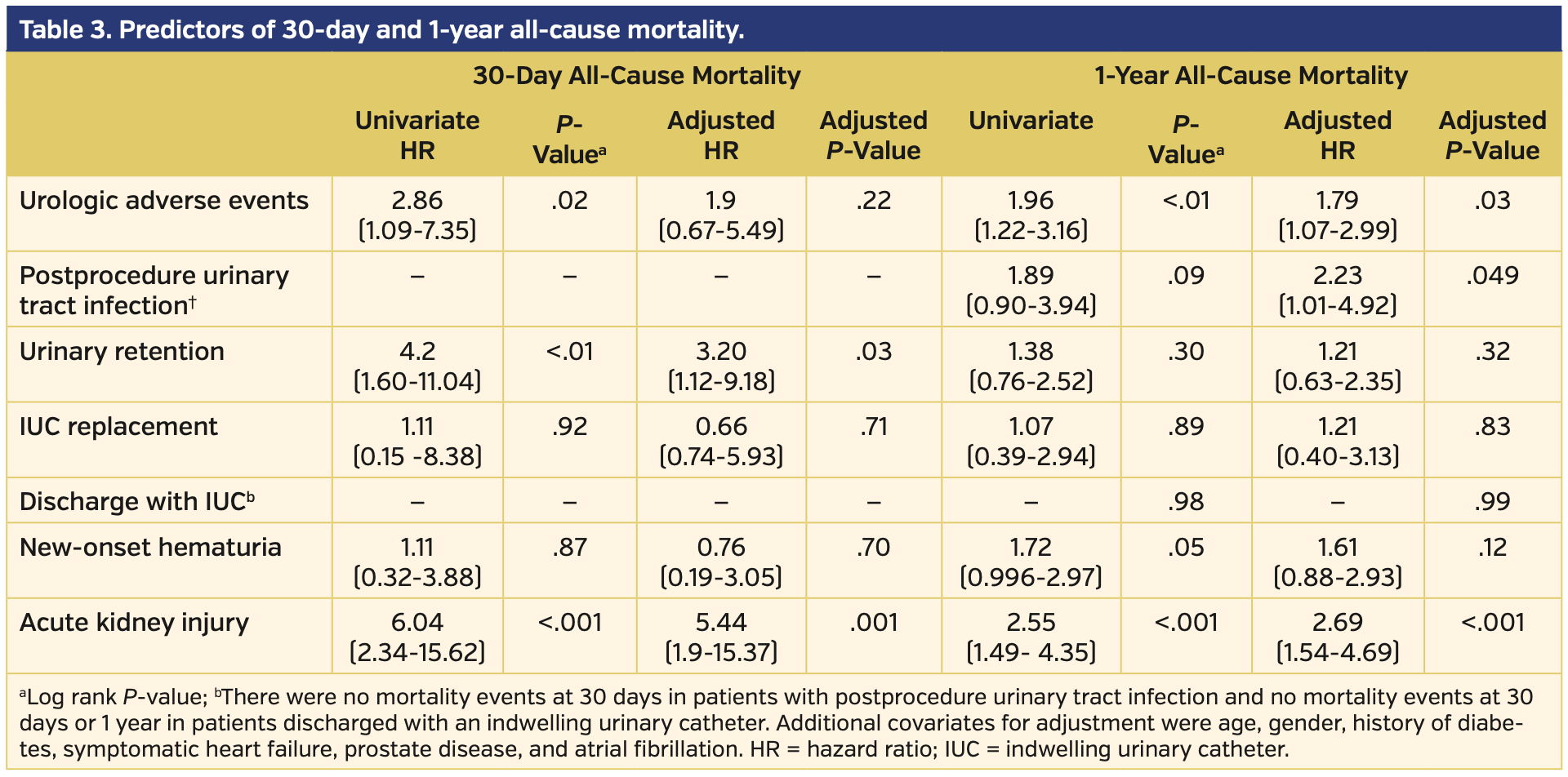ADVERTISEMENT
Urologic Complications in Patients Receiving Indwelling Urinary Catheters During Transcatheter Aortic Valve Replacement
Abstract: Objectives. The minimalist approach to transcatheter aortic valve replacement (TAVR) focuses on avoiding extraneous invasive measures. Data describing the clinical impact of routine indwelling urinary catheter (IUC) in TAVR patients is limited. We sought to examine outcomes after IUC placement in patients undergoing TAVR. Methods. We performed a retrospective analysis of 773 consecutive patients undergoing TAVR between 2011 and 2015. Patients were excluded who did not receive an IUC, had a pre-existing IUC, had renal replacement therapy, or underwent non-transfemoral TAVR. Patients were classified by presence of the composite of in-hospital urologic adverse events (UAEs), defined as urinary retention, IUC reinsertion, discharge with IUC, new hematuria, or urinary tract infection (UTI). The primary study endpoint was all-cause mortality at 1 year. Results. A total of 520 patients met study criteria and were analyzed. The incidence of UAE was 28.6%. Urinary retention after IUC removal occurred in 14.6% of patients. UTIs occurred in 6.5% and acute kidney injury occurred in 13.6% of IUC patients. UAE was associated with an increased rate of 30-day and 1-year all-cause mortality (hazard ratio [HR], 2.84; 95% confidence interval [CI], 1.09-7.35; P=.02 and HR, 1.96; 95% CI, 1.22-3.16; P<.01, respectively). After multivariable adjustment for important baseline differences, UAEs were associated with significantly greater hazard of 1-year mortality (adjusted HR, 1.79; 95% CI, 1.07-2.99; P=.03) but not 30-day mortality (adjusted HR, 1.96; 95% CI, 0.67-5.49; P=.22). Conclusion. UAEs were frequent in patients receiving an IUC during TAVR and were associated with substantial morbidity, as well as longer hospital stay. Further research is required to establish whether avoidance of IUC as a component of the minimalist approach will reduce UAEs.
J INVASIVE CARDIOL 2020;32(7):269-274.
Key words: acute kidney injury, indwelling urinary catheter, TAVR outcomes, urinary tract infection
Transcatheter aortic valve replacement (TAVR) has evolved into a primary therapy for high-risk and inoperable patients1-3 with symptomatic severe aortic stenosis and is now an accepted alternative to surgery in the intermediate-risk patient population.4,5 As TAVR extends into lower-risk groups, the achievement of optimal procedural results with the lowest possible complication rate has become the field standard.
The “minimalist approach” to TAVR6,7 seeks to minimize complications by adopting the least invasive means possible to successfully accomplish the procedure. It typically favors the use of conscious sedation or monitored anesthesia care rather than general anesthesia and transthoracic rather than transesophageal echocardiography.8,9 The minimalist approach also frequently involves avoidance of additional invasive procedures, such as placement of central venous catheters. Multiple studies have supported the “minimalist approach” demonstrating comparable safety outcomes while achieving lower cost and shorter length of stay after TAVR.6,10-12
A common procedure during TAVR that may be associated with adverse outcomes is placement of an indwelling urinary catheter (IUC). Patients undergoing TAVR are typically in their 8th to 9th decade of life13 and carry increased risk of urologic complications with invasive bladder catheterization due to age and comorbidities, such as chronic urinary tract infection, benign prostatic hypertrophy, and prostate cancer.14 Despite these risks, many centers have traditionally utilized routine invasive urinary bladder catheterization as part of TAVR protocols. This study seeks to establish the incidence and clinical implications of urologic complications in patients undergoing routine invasive bladder catheterization during TAVR.
Methods
Data were retrospectively collected for consecutive patients treated with transfemoral TAVR between 2011 and 2015 and had an IUC routinely placed as part of standard TAVR during this period. Patients were excluded if they did not receive an IUC or had a pre-existing IUC upon hospital admission, were undergoing renal-replacement therapy, or had non-transfemoral TAVR. All TAVRs were performed at Columbia University Medical Center in New York, New York, and the study was approved by the Columbia University institutional review board.
Endpoints and definitions. Patient data were obtained through retrospective record review. Thirty-day and 1-year mortality events were acquired through data linkage to the Transcatheter Valve Therapy (TVT) registry or applicable clinical trial databases. Patients were categorized according to the presence or absence of composite urologic adverse events (UAEs), defined as urinary retention, need for IUC reinsertion due to urinary retention, discharge with IUC, new hematuria, or urinary tract infection (UTI). The primary study endpoint was all-cause mortality at 1 year. The secondary endpoints included 30-day mortality, acute kidney injury (AKI), IUC days, and hospital days. AKI was defined according to the Valve Academic Research Consortium (VARC)-2 definition as an increase in serum creatinine to 150%-199%, an increase in creatinine (Cr) of ≥0.3 mg/dL, or urine output <0.5 mL/kg/hour for >6 hours. UTI was defined as documentation of UTI in the medical record with initiation of new antimicrobial therapy. Urinary retention was determined by documentation of failure to void after removal of the IUC or documentation of a post-void residual volume >200 mL,15,16 and hematuria was defined as documented, new-onset gross hematuria. Mortality endpoints were adjudicated within the TVT registry and based on clinical trial protocols.17 Disabling stroke, major vascular complications, and bleeding complications were adjudicated according to the VARC-2 guidelines.18
Statistical analysis. Normally distributed continuous variables were reported as mean with standard deviation and compared with the Student's t-test; continuous variables that were non-normally distributed were reported as median with first and third quartiles and compared with the Mann-Whitney U-test. Categorical variables were summarized as percentages and compared using Chi-square or Fisher's exact test, as appropriate. Results were reported as odds ratio (OR) with 95% confidence interval (CI). Mortality endpoints were calculated as time-to-event using Kaplan-Meier methods. Cox proportional hazard models were used to evaluate multivariable predictors of mortality from the index procedure to 30 days and 1 year. Clinically important covariates incorporated into the model included age, gender, history of diabetes, symptomatic heart failure, prostate disease, atrial fibrillation, and composite UAE. A second model was constructed as above with the addition of gender as an interaction term with UAE. A third model was then constructed using the same baseline covariates (without the interaction terms) with the addition of the individual components of UAE. A landmark analysis was performed to examine patient outcomes from 30 days to 1 year to adjust for patients with early complications (in-hospital disabling stroke, major vascular complications, major bleeding) added to the models. A two-sided P-value <.05 was considered statistically significant. Statistical analyses were performed with SAS, version 9.4 (SAS).
Results
Patient and procedural characteristics. Of the 773 patients screened, a total of 520 underwent transfemoral TAVR, received an IUC, and met study inclusion criteria (Figure 1). Of these, a total of 149 (28.7%) developed a UAE. Baseline characteristics were compared between the UAE group and the no-UAE group (Table 1). Patients with UAE were more frequently men (55.0% vs 44.7%; P=.04) and had higher frequency of baseline atrial fibrillation (51.7% vs 41.2%; P=.03) and pre-existing prostate disease (32.9% vs 21.1%; P=.01) than those with no UAE. The Society of Thoracic Surgeons risk score did not significantly differ between groups (UAE 7.8% vs No UAE 8.2%; P=.37). There were also no significant differences in the mean amount of iodinated contrast received (68.1 mL vs 72.7 mL; P=.27) or the procedure duration (209.1 min vs 202.5 min; P=.28). Patients who developed UAE had significantly greater median days with an IUC (2 days vs 1 day; P<.001 and a greater hospital median length of stay (7 days vs 5 days; P<.001) than those with no UAE.
Frequency of component UAEs and differences according to gender. New-onset gross hematuria was the most frequent UAE and occurred in 16.1% of patients overall. Gross hematuria was significantly more common in men than in women (23.0% vs 9.9%; P=.03). Urinary retention was also a common UAE that occurred in 14.6% of patients overall. While numerically more men had urinary retention than women, the difference was not statistically significant (17.3% vs 12.1%; P=.09). Of patients who did experience urinary retention, 35.5% required reinsertion of the indwelling IUC and 29.6% required an IUC at the time of hospital discharge. The vast majority of patients (87.5%) with retention leading to an IUC at discharge were male. In contrast, postprocedure UTI occurred in 6.5% of patients with a numerically lower frequency in men compared to women (4.4% vs 8.5%; P=.06) (Figure 2).
Outcomes after UAE. The development of a UAE was associated with a significantly higher rate of 30-day mortality (UAE 6.1% vs No UAE 2.2%; HR, 2.84; 95% CI; 1.09-7.35; P=.03) and 1-year mortality (UAE 20.9% vs No UAE 11.8%; HR, 1.96; 95% CI, 1.22-3.16; P<.01) (Table 2, Figure 3). Important periprocedural adverse events (disabling stroke, major vascular complications, and major bleeding) also occurred at a higher frequency in UAE patients. After multivariable adjustment for important baseline differences (Table 3), UAEs were associated with significantly greater hazard of 1-year mortality (adjusted HR, 1.79; 95% CI, 1.07-2.99; P=.03) but not 30-day mortality (adjusted HR, 1.96; 95% CI, 0.67-5.49; P=.22).
Of the individual components of UAE, only postprocedural urinary retention was associated with adjusted 30-day mortality; however, this association was no longer present at 1 year. Postprocedure AKI (which was not a component of the composite UAE) was seen to be independently predictive of adjusted 30-day and 1-year mortality (1-year adjusted HR, 2.69; 95% CI, 1.54-4.69; P<.001).
To assess whether the association of UAEs with mortality varied among males and females, an interaction term was added to the multivariable model. In females, the risk of 1-year mortality increased in patients with UAE (adjusted HR, 3.73; 95% CI, 1.75-7.98; Pinteraction=.01). However, in males, there was no increase in mortality risk with UAE (HR, 1.01; 95% CI, 0.50-2.04).
Lastly, a landmark analysis was performed from 30 days to 1 year to adjust for VARC-2 defined in-hospital major stroke, major vascular complication, or major bleeding that may have extended urinary catheter days. A greater crude mortality rate was seen from 30 days to 1 year in those with UAEs (16.8% vs 10.6%; P=.02). After multivariable adjustment, the association was no longer statistically significant at 1 year (adjusted HR, 1.66; 95% CI, 0.92-3.00; P=.09) (Figure 3B).
Discussion
The primary findings of this study are as follows: (1) the incidence of UAE in TAVR patients who underwent routine preprocedural IUC insertion was very high, occurring in nearly 30% of patients; (2) UAE was associated with significantly higher crude mortality at 30 days and a higher crude and adjusted mortality at 1 year (adjusted HR, 1.79; 95% CI, 1.07-2.99; P=.03); and (3) UAE was also associated with more frequent AKI (P<.001), greater median number of catheter days (2.0 days vs 1.0 days; P<.001), and longer hospital stay (7.0 days vs 5.0 days; P<.001).
Given the overall movement toward a minimalist approach to TAVR with less invasive monitoring,6,10,12,19 avoidance of IUCs may seem intuitive. However, the rate of urologic complications and potential impact of avoiding routine IUC placement after TAVR have not been well established, with only a single, small study in the literature.20 Therefore, some centers continue to routinely place an IUC as part of the periprocedural care of TAVR patients. The knowledge that UAE occurred in nearly one-third of TAVR patients who received IUC and were associated with other adverse clinical outcomes, including mortality, suggests that strategies are needed to reduce urologic complications. One such intervention might be the avoidance of routine IUC as part of the minimalist approach to TAVR.
It is plausible that UAE events may lead to additional adverse clinical outcomes, culminating directly or indirectly in mortality in the TAVR patient population, which is typically characterized by advanced patient age, high comorbidity burden, and frailty. Frailty in particular is a syndrome of decreased physiological reserves and increased susceptibility to stressors that has previously been associated with adverse outcomes, including in the TAVR population.21-23 Elderly, comorbid patients may be more susceptible to poor outcomes when complications such as UAE occur. On the other hand, the finding of an association of UAE with 30-day and 1-year mortality may be explained by a higher rate of periprocedural adverse events, such as disabling stroke, in the UAE group. When we adjusted for these complications in the landmark analysis, the mortality signal was no longer statistically significant.
Consistent with data in other medical fields,24-26 UAE was also associated with higher median number of urinary catheter days (2.0 vs 1.0; P<.001) and longer lengths of stay (median 7.0 days vs 5.0 days; P<.001). Aside from important clinical benefits, avoidance of IUC may therefore also have important cost implications.27,28 Furthermore, UAE was associated with greater odds of AKI, which importantly conflicts with recent studies advocating enhanced invasive monitoring of urinary output after TAVR to lower rates of AKI.29,30 It is plausible that the higher AKI frequency with UAE in this study was due to post renal kidney injury from urinary retention or sequelae from UTI.
The patterns of UAE were notably different based on gender, with male patients having a greater incidence of UAE than female patients (33.1% vs 24.6%; P=.03). Men had a significantly higher frequency of IUC replacement and requirement for IUC at discharge as well as numerically greater rates of urinary retention than women. The occurrence of gross hematuria in nearly one-quarter of the male patients exemplifies the high risk of a UAE that is relatively unlikely to occur in the absence of routine IUC placement for TAVR. The hematuria frequency in our study of 16.1% is similar to a prior study by Lau et al, which reported gross hematuria in 17.6% of patients.20 Women also experienced a nearly 1 in 4 risk of UAE, although this was driven by a higher incidence of postprocedure UTI. Furthermore, females with UAE had a significantly higher hazard for mortality compared with females without UAE (Pinteraction=.01), unlike males in whom UAE was not associated with mortality.
Further research will be required to determine the potential impact of avoiding routine IUC on the individual component outcomes of UAE. Given the significant sex-related differences in these, it is possible that the avoidance of IUC as part of a minimalist approach to TAVR may have differential impacts on men and women.
Study limitations. This is a single-center, retrospective study; therefore, the results may not be generalizable to all other centers. Given the extraction of mortality data from the TVT registry and other clinical trial databases, the exact cause of death was not available in many cases. Also, limited data were available on baseline comorbidity burden, ie, frailty metrics, and despite the use of multivariable adjustment for outcome analysis, the possibility of unmeasured confounding remains. Lastly, as patients routinely received IUC during the study time period, no contemporary control group was available for comparison of the incidence of UAE without routine IUC use.
Conclusion
Urologic complications were frequent in patients who received routine IUC while undergoing transfemoral TAVR and were associated with substantial morbidity. These findings should prompt further research and reassessment of protocols for routine IUC placement during TAVR. The significant morbidity associated IUCs should prompt reassessment of institutional TAVR protocols that include routine placement of IUCs.
From the 1Division of Cardiology, Columbia University Medical Center, New York, New York; and the 2Cardiovascular Research Foundation, New York, New York.
Disclosure: The authors have completed and returned the ICMJE Form for Disclosure of Potential Conflicts of Interest. Dr Finn reports grant support from NIH T32 HL00785422. Dr Khalique reports speaking fees from Edwards Lifesciences and Boston Scientific and is a member of a cardiovascular core laboratory that holds contracts with Edwards Lifesciences (no direct compensation). Dr Hahn reports speaker fees from Philips Healthcare, St. Jude Medical, and Boston Scientific; core laboratory contracts with Edwards Lifesciences (no direct compensation). Dr Vahl reports grant support from Edwards Lifesciences and Medtronic; consulting fees from Abbott and JenaValve. Dr George reports consultant fees from Edwards Lifesciences, Medtronic, Abbott, WL Gore, Bolton Medical, and Boston Scientific. Dr Leon is an unpaid member of the scientific advisory board of Edwards Lifesciences; principal Investigator of the PARTNER and PARTNER 2 trials (all travel and customary expenses associated with trial management reimbursed by Edwards Lifesciences). Dr Kirtane reports institutional funding to Columbia University and/or Cardiovascular Research Foundation including fees paid to Columbia University and/or Cardiovascular Research Foundation for speaking engagements and/or consulting, from Medtronic, Abbott Vascular/St. Jude, Boston Scientific, Abiomed, CathWorks, Siemens/Corindus, Philips/Spectranetics, ReCor Medical, Cardiovascular Systems, Inc; non-financial support (including meals/travel reimbursement) from Chiesi, Opsens, Zoll, Regeneron, Medtronic, Abbott Vascular/St. Jude, Boston Scientific, Abiomed, Siemens/Corindus, Philips/Spectranetics, ReCor Medical, Cardiovascular Systems, Inc. Dr Kodali reports grant support from Edwards Lifesciences, Medtronic, and Abbott; personal fees from Abbott, Admedus, and Meril; equity in Biotrace and Thubrikar. Dr Nazif reports personal fees from Edwards Lifesciences, Medtronic, and Boston Scientific; personal fees/equity in Venus Medtech. The remaining authors report no conflicts of interest regarding the content herein.
Manuscript submitted November 30, 2019, provisional acceptance given December 3, 2019, final version accepted December 6, 2019.
Address for correspondence: Tamim M. Nazif, MD, Division of Cardiology, Columbia University Medical Center, 161 Fort Washington Ave, Herbert Irving Pavilion, 6th Floor, New York, NY 10032. Email: Tmn31@columbia.edu
- Makkar RR, Fontana GP, Jilaihawi H, et al. Transcatheter aortic-valve replacement for inoperable severe aortic stenosis. N Engl J Med. 2012;366:1696-1704.
- Leon MB, Smith CR, Mack M, et al. Transcatheter aortic-valve implantation for aortic stenosis in patients who cannot undergo surgery. N Engl J Med. 2010;363:1597-1607.
- Smith CR, Leon MB, Mack MJ, et al. Transcatheter versus surgical aortic-valve replacement in high-risk patients. N Engl J Med. 2011;364:2187-2198.
- Nishimura RA, Otto CM, Bonow RO, et al. 2017 AHA/ACC focused update of the 2014 AHA/ACC guideline for the management of patients with valvular heart disease: a report of the American College of Cardiology/American Heart Association Task Force on Clinical Practice Guidelines. J Am Coll Cardiol. 2017;70:252-289.
- Thourani VH, Kodali S, Makkar RR, et al. Transcatheter aortic valve replacement versus surgical valve replacement in intermediate-risk patients: a propensity score analysis. Lancet. 2016;387:2218-2225.
- Lauck SB, Wood DA, Baumbusch J, et al. Vancouver transcatheter aortic valve replacement clinical pathway: minimalist approach, standardized care, and discharge criteria to reduce length of stay. Circ Cardiovasc Qual Outcomes. 2016;9:312-321.
- Durand E, Borz B, Godin M, et al. Transfemoral aortic valve replacement with the Edwards SAPIEN and Edwards SAPIEN XT prosthesis using exclusively local anesthesia and fluoroscopic guidance: feasibility and 30-day outcomes. JACC Cardiovasc Interv. 2012;5:461-467.
- D’Errigo P, Ranucci M, Covello RD, et al. Outcome after general anesthesia versus monitored anesthesia care in transfemoral transcatheter aortic valve replacement. J Cardiothorac Vasc Anesth. 2016;30:1238-1243.
- Dall’Ara GH, Eltchaninoff N, Moat C, et al. Local and general anaesthesia do not influence outcome of transfemoral aortic valve implantation. Int J Cardiol, 2014;177:448-454.
- Babaliaros VC, Devireddy S, Lerakis RL, et al. Comparison of transfemoral transcatheter aortic valve replacement performed in the catheterization laboratory (minimalist approach) versus hybrid operating room (standard approach): outcomes and cost analysis. JACC Cardiovasc Interv. 2014;7:898-904.
- Condado JF, Haider MN, Lerakis S, et al. Does minimalist transfemoral transcatheter aortic valve replacement produce better survival in patients with severe chronic obstructive pulmonary disease? Catheter Cardiovasc Interv. 2017;89:775-780.
- Jensen HA, Condado JF, Devireddy C, et al. Minimalist transcatheter aortic valve replacement: the new standard for surgeons and cardiologists using transfemoral access? J Thorac Cardiovasc Surg. 2015;150:833-839.
- Holmes DR Jr, Nishimura RA, Grover FL, et al. Annual outcomes with transcatheter valve therapy: from the STS/ACC TVT registry. J Am Coll Cardiol. 2015;66:2813-2823.
- Platt R, Polk BF, Murdock B, Rosner B. Mortality associated with nosocomial urinary-tract infection. N Engl J Med. 1982;307:637-642.
- Malik RD, Cohn UA, Bales GT. Urinary retention in elderly women: diagnosis & management. Curr Urol Rep. 2014;15:454.
- Selius BA, Subedi R. Urinary retention in adults: diagnosis and initial management. Am Fam Physician. 2008;77:643-650.
- Carroll JD, Edwards FH, Marinac-Dabic D, et al. The STS-ACC transcatheter valve therapy national registry: a new partnership and infrastructure for the introduction and surveillance of medical devices and therapies. J Am Coll Cardiol. 2013;62:1026-1034.
- GUSTO Investigators. An international randomized trial comparing four thrombolytic strategies for acute myocardial infarction. N Engl J Med. 1993;329:673-682.
- Kamioka N, Wells J, Keegan P, et al. Predictors and clinical outcomes of next-day discharge after minimalist transfemoral transcatheter aortic valve replacement. JACC Cardiovasc Interv. 2018;11:107-115.
- Lauck SB, Kwon JY, Wood DA, et al. Avoidance of urinary catheterization to minimize in-hospital complications after transcatheter aortic valve implantation: an observational study. Eur J Cardiovasc Nurs. 2018;17:66-74.
- Robinson TN, Wu DS, Pointer L, Dunn CL, Cleveland JC Jr, Moss M. Simple frailty score predicts postoperative complications across surgical specialties. Am J Surg, 2013;206:544-550.
- Afilalo J, Alexander KP, Mack MJ, et al. Frailty assessment in the cardiovascular care of older adults. J Am Coll Cardiol. 2014;63:747-762.
- Green P, Arnold SV, Cohen DJ, et al. Relation of frailty to outcomes after transcatheter aortic valve replacement (from the PARTNER trial). Am J Cardiol. 2015;116:264-269.
- Stephan F, Sax H, Wachsmuth M, Hoffmeyer P, Clergue F, Pittet D. Reduction of urinary tract infection and antibiotic use after surgery: a controlled, prospective, before-after intervention study. Clin Infect Dis. 2006;42:1544-1551.
- El-Mazny A, El-Sharkawy M, Hassan A. A prospective randomized clinical trial comparing immediate versus delayed removal of urinary catheter following elective Cesarean section. Eur J Obstet Gynecol Reprod Biol. 2014;181:111-114.
- Mitchell BG, Ferguson JK, Anderson M, Sear J, Barnett A. Length of stay and mortality associated with healthcare-associated urinary tract infections: a multi-state model. J Hosp Infect, 2016;93:92-99.
- Brown JW, Boyd JH, Patel PM, et al. Transcatheter aortic valve replacement versus aortic valve bypass: a comparison of outcomes and economics. Ann Thorac Surg. 2016;101:49-54.
- Patel N, Doshi R, Kalra R, Bajaj NS, Arora G, Arora P. Costs of transcatheter aortic valve replacement: implications of proposed Medicare cuts. JACC Cardiovasc Interv. 2018;11:610-612.
- Barbanti M, Gulino S, Capranzano P, et al. Acute kidney injury with the RenalGuard system in patients undergoing transcatheter aortic valve replacement: the PROTECT-TAVI trial (PROphylactic effecT of furosEmide-induCed diuresis with matched isotonic intravenous hydraTion in Transcatheter Aortic Valve Implantation). JACC Cardiovasc Interv. 2015;8:1595-1604.
- Solomon R, Werner C, Mann D, D’Elia J, Silva P. Effects of saline, mannitol, and furosemide on acute decreases in renal function induced by radiocontrast agents. N Engl J Med. 1994;331:1416-1420.






